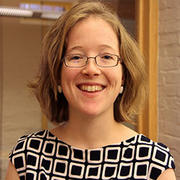
On April 11, 2017, a group of thirty students, faculty, and community members gathered in the Center for the Study of World Religion (CSWR) Common Room for When We Walked: Pilgrimage in Hinduism. The final gathering for Melissa Coles’ Junior Fellowship series When We Walked: Pilgrimage Across Tradition, the group expressed happy disbelief at their year-long journey: a journey that examined pilgrimage through dialogue across tradition and perspective.
The structure of the series guided this journey. Participants gathered one Tuesday per month, 5:15-7pm. Each gathering focused on pilgrimage in a particular tradition and featured two speakers—one academic and one experiential—who each spoke for twenty minutes. After the speakers’ presentations, the event opened to group dialogue. This section of the event began with a respondent, chosen at the gathering directly prior, who was from a different tradition. After this interreligious response, the conversation opened to the room for reflections, queries, and stories.
Each month’s gathering was well attended with around thirty people, and each gathering lit up different parts of the world’s landscapes—their paths, histories, and monuments. Conversations were engaging, rich, provocative, and diverse. To provide a taste of the year, each gathering’s topic, presenters, and the first respondent will be listed below. Then, one question that arose during that event will be noted. This imparts a taste of conversations wrestled with, shared, and held throughout the series.
When We Walked: Pilgrimage Across Tradition: on September 20, 2016, the journey began with an open meeting where each person shared her personal experiences and thoughts on pilgrimage. We reflected: where are we compelled to go on religious and non-religious pilgrimage?
When We Walked: Pilgrimage in Islam: on October 11, 2016, Norbert Litoing presented “Touba, ‘Africa’s Little Mecca:’ The Magal and the Construction of African-Muslim Identities,” Munjed Murad presented “Islamic Metaphysical Considerations: Pilgrimage and Its Significance,” and Olga Turcotte was the first respondent. We asked: why do we need pilgrimage?
When We Walked: Pilgrimage in Buddhism: on November 15, 2016, Professor Charles Hallisey presented “Pilgrimages are Good to Think With: Notes on Reading Academic Studies of Buddhist Pilgrimage,” Seonjoon Young presented “Journeying In-Between: Experiences of Pilgrimage in South and East Asia,” and Professor Jacob Olupona was the first respondent. We wondered: how does time affect pilgrimage?
When We Walked: Pilgrimage in Judaism: on January 31, 2017, Rabbi Sally Finestone presented “If I forget thee, O Jerusalem...,” Mimi Micner presented “Jewish Homelands and Diasporas: Jewish Journeys to Israel and Eastern Europe,” and Seonjoon Young was the first respondent. We questioned: how do pilgrimage, personal stories, and communal stories interconnect?
When We Walked: Pilgrimage in Mormonism: on February 21, 2017, Professor David Holland presented “Migrations, Commemorations, and Pilgrimages,” Jenna Alatriste presented “The House of the Lord: Temples in the Latter-day Saint Tradition,” and Norbert Litoing was the first respondent. We pondered: why do we pilgrim differently to a place next door to us versus to a place on the other side of the world?
When We Walked: Pilgrimage in Diné Culture & to Native American Sacred Places: on March 21, 2017, Professor Rosalyn LaPier presented “Why Standing Rock Became a Place of Pilgrimage,” Damon Clark presented “Walking in Beauty,” and Professor Anna Sun was the first respondent. We questioned: who has power, and how should pilgrims pay attention to power dynamics?
When We Walked: Pilgrimage in Hinduism: on April 11, 2017, Professor Diana Eck presented “Pilgrimage in Hindu India: Shiva in the Landscape of Pilgrimage,” Swami Tyagananda presented "Going Places to Find the Self,” and Meghan Finn was the first respondent. We asked: how are death and dying received on pilgrimage?
Throughout the seven gatherings, When We Walked: Pilgrimage Across Tradition has been a fertile space for wondering and learning across tradition and perspective. There are no clear-cut answers to the questions listed above. What is clear is that we shared with one another our knowledge of and experience with living landscapes. At the last gathering, for example, Mt. Kailash and Kashi were lit up for us. Going forward, all are invited to continue this work: to continue to learn, share, and grow through pilgrimage and interfaith dialogue. All are invited to ponder: where is your living landscape?
- Melissa Coles, CSWR Junior Fellow 2016-2017, HDS Master of Divinity Candidate 2017
